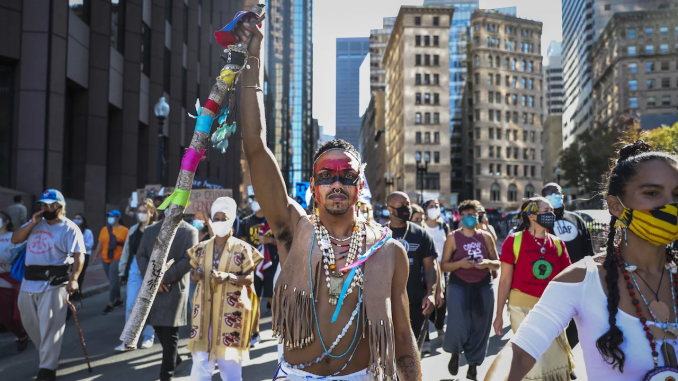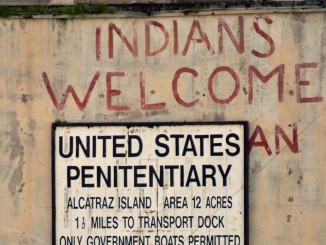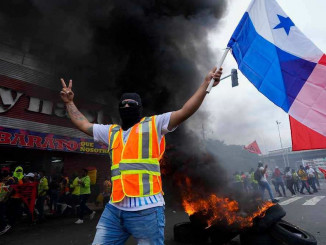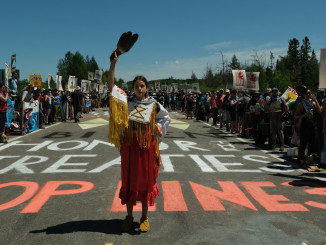
(This is a slightly updated reprint of a 2020 article by Speak Out Now.)
Monday, October 10, 2022 is Indigenous People’s Day, but the longstanding U.S. tradition is to celebrate it as Columbus Day. The official change of name was marked in 1989 with a decree by the state of South Dakota. This has created controversy for some. But does it matter what we call it?
It matters because a choice must be made. Whose history is told? The history of the conquerors and exploiters? Or the history of those who struggled against them for survival? Through whose eyes do we choose to look at history? To look at history through the eyes of the oppressor is to erase the history of those they oppressed. To look at history through the eyes of the oppressed is to look at the nature of the society that creates the oppression.
Before the Invasion
Before Christopher Columbus and other Europeans began their conquest of the Western Hemisphere, the region had a diversity of societies and cultures. In North America alone, there were many hundreds of different cultural groups speaking at least 300 distinct languages.
The image of ruthless warriors is a racist fantasy that supported the genocidal extermination of whole societies. In fact, people lived in very different ways, adapted to the environment they lived in and how they got their food. Many bands or tribes lived by the gathering of plants, nuts, and roots, and fishing and hunting animals. Some moved with the animals they hunted or changed residence according to the season and availability of plant-based foods. Others, like the Tlingit and Haida of the lush northwest coast, lived in villages of hundreds of people, relying on the massive migrations of salmon as a staple of their diet.
More than 1,000 years ago (950–1350) in the area across the Mississippi River from present-day St. Louis, was the city of Cahokia. It was similar in size to London at that time with a population of around 15,000. It was a corn-based agricultural society (corn, or maize, was first domesticated in present-day Mexico). Cahokia occupied about six square miles, and included about 120 large man-made earthen mounds or flat-topped pyramids. Located on the Mississippi River, it was the center of a large trade network that extended throughout North America.
Further to the east were a wide-variety of cultural groupings, sometimes referred to as nations because of the number of people organized and their political complexity. They relied on mixed economies of cultivation of varieties of domesticated grains and other plants as well as hunting and fishing, or relied primarily on gathering, hunting, and fishing. From the Seminoles in the southeast to the Iroquois in the north, they built alliances based on trade and later based on defending themselves from the European invasion.
Their political and social organizations were as diverse as the lands where they lived. The cultural variations were great – some were matrilineal, tracing lineage through the women; others patrilineal, tracing descent through the men; and some were bilineal, tracing kinship through both parents. Some allowed for multiple spouses, a considerable number recognized gender beyond male and female as “twin-spirited,” embodying characteristics viewed as both female and male and having special roles in the society. Women usually participated with men in making important decisions for the band or tribe or nation. There was no reason to restrict the capabilities of individuals, as the contributions of each were shared by all – whether it was story-telling, music, other arts, or knowledge of the environment they depended on.
Land was not individually owned. Although in some societies, chiefs had rights to a certain amount of what was produced or collected, it was not for their own consumption or control, but for redistribution at feasts. These ways of life were disrupted by the forcible introduction of another way of life – capitalism.
The Virus of Colonization
Christopher Columbus was an Italian explorer who was financed by the Spanish empire to find a more direct route to Asia. Sailing west across the Atlantic Ocean, he landed on Caribbean islands, believing he was in Asia. The first act of colonization and exploitation began on the island which was called Ayti (Haiti) by the Taino people who lived there. Columbus described the Taino as
“… so naive and so free with their possessions that no one who has not witnessed them would believe it. When you ask for something they have, they never say no. To the contrary, they offer to share with anyone …”
Thus began the war of more than 500 years on the people of the Western Hemisphere. Indigenous people were exposed to diseases they had never encountered which sickened and killed whole populations. There were attempts by Europeans to enslave people. As the attempt to colonize North America and later to create a nation took hold, the Europeans used horrific raids on villages and later systematic warfare and forced removals at gunpoint of tens of thousands of people to make the lands available for the European invaders. One of the most notorious examples in the United States was the “Trail of Tears,” the forced march of the people of the Cherokee, Muscogee, Seminole, Chickasaw, and Choctaw nations in the middle of the winter of 1838 from their homelands in Georgia and Alabama to what is today Oklahoma. It is estimated that half of the 16,000 men, women, and children died on the march. This was part of the larger forced removal of more than 100,000 members of these nations from their lands.
People were pushed off their homelands into reservations, often in the least desirable and most barren, unproductive regions. People lost their entire means of subsistence as a result of the Europeans’ attempts to break their connection to the land and destroy their cultures. And the lands they were forced onto were not uninhabited, which often created clashes between the people living there and the new arrivals.
Today there are 326 reservations, and the U.S. government recognizes 574 different tribal groups while refusing to recognize others, claiming they are not “legitimate.” And although there were more than 500 treaties signed between the U.S. government and different tribal groupings, sometimes at the end of a period of war where U.S. forces were defeated, the sovereignty and rights of indigenous people continue to be denied.
As organized armed resistance by Native Americans in the west was eventually broken by the overwhelming force of U.S. imperialism toward the end of the 1800s, the U.S. government began a new policy of obliterating indigenous cultures: boarding schools. The Bureau of Indian Affairs and other organizations set up these schools to so-called “civilize” people who lived on the reservations. In reality, what this meant was that throughout the Twentieth Century, thousands of children were forcibly taken from their families and raised in overcrowded, disease-ridden facilities run by white administrators and white teachers, with no access to their families and no access to adequate health care. There, the children were often subjected to military protocols. They were made to carry out manual labor, wear European-style uniforms, and speak English. They were taught American history through the eyes of the colonizers, and they were beaten if they spoke their native language. These boarding schools continued in some places as late as the 1990s. Over 150,000 children were abducted into these boarding schools over the years, and an estimated 40,000 children died while at or because of these schools.
Despite the genocidal activities of the U.S. government and the continued denial of their rights, indigenous people in the U.S. have not disappeared. Far from it! There are at least 5.7 million Native Americans, according to the U.S. Census Bureau, which acknowledges serious under-counting — by as much as five percent on the reservations. Many have maintained their cultures and tradition of struggle.
But the virus of capitalism continues its persistent assault on the native population, attempting to marginalize and decimate them. There are battles over water and land. Some reservations are treated as dumping grounds for hazardous materials by businesses and the military. A somewhat recent example is the Church Rock uranium mill spill where, in 1979, a dam collapse led to radioactive waste working its way into the water supply of the Navajo nation.
Poverty and lack of access to decent food and health care led to the Covid pandemic having a devastating impact on many reservations, but in urban areas as well. Overall, Covid has been devastating, with infection rates 3.5 times that of the white population. Some reservations had the highest infection and death rates (often of younger people) of the entire country. People in a number of reservations took matters into their own hands, closing their reservations to all through-traffic and unauthorized visitors, bringing the infection rate down.
Standing against invading forces is deeply rooted in many indigenous communities. They have taken the lead in fights against destructive logging practices and against oil pipeline construction, the resistance at Standing Rock being just one example of many.
What choice will we make?
So, does it even matter if we call the day “Columbus Day” or “Indigenous People’s Day”? It doesn’t change the past. But it can impact our future. How we answer this question forces us to recognize the genocide and enormous theft of indigenous people’s land, labor and resources that are at the foundation of this society. That in turn leads us to acknowledge the theft of people stolen from Africa and their stolen labor through slavery and then the incalculable amounts of wealth stolen from the labor of all working people that continues to this day.
The U.S. empire was built on theft. The pandemic, climate catastrophe, political and economic instability, and increasing military rivalries are all clear indicators that this empire is not healthy. As many problems continue to unfold around us, will we cling to the path that has led us here? Or will we organize ourselves to fight to build a different future that values all life and the planet?




